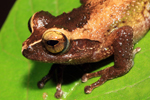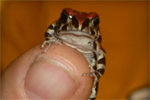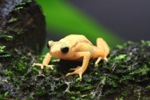Over the past 30 years, amphibians worldwide have been infected with a lethal skin disease known as the amphibian chytrid fungus (Batrachochytrium dendrobatidis).
“The disease can cause rapid mortality, with infected frogs of susceptible species dying within weeks of infection in the laboratory.” Jodi Rowley, a herpetologist with the Australian Museum told mongabay.com. “This disease has now been associated with declines and extinctions in hundreds of species of amphibians worldwide, and is a serious threat to global amphibian biodiversity.”
But Rowley, along with Ross Alford from James Cook University, have just published a study that might provide a clue as to how individual frogs may fight the disease.
For the first time, individual frog body temperatures have been connected to the effects of the amphibian chytrid infection in the wild. “[T]he likelihood of a frog being infected declines rapidly with the time they spend above the pathogen’s upper optimal temperature,” explains Rowley, “by basking in the sun, or sitting on warm rocks, frogs may actually be ridding themselves of infection.”
As part of the study, Rowley, Prof. Alford, and a small team of volunteers tracked 3 amphibian species in the rainforests of northeast Queensland, monitoring each subject’s temperature both daily and nightly for 16 days.
“The study involved tracking over 100 [individual] amphibians in rainforest streams,” Rowley says. “We used radio-transmitters weighing less than 0.6g [0.02 oz] in weight, or diodes that were even smaller, fitted by a tiny waist-belt and tracked these frogs.”
After two weeks of “intensive frog-stalking,” the research results showed a remarkable pattern: the warmer the frogs were, the less likely they were to be infected with amphibian chytrid. To be exact, frogs were “very unlikely” to be infected if at least 75% of their body was over 77 degrees Fahrenheit (25 degrees Celsius).
Although the exact reason for the pattern is unknown, Rowley theorizes that the frogs’ immune systems operate more efficiently at warmer temperatures. As when humans get fevers, a high temperature may help the frog fight off the infection. Or, the fungus may simply start dying at high temperatures.
Rowley happily stated, “Whatever the cause, frogs that spend more time at hotter temperatures were less likely to be infected!”

One of the three species studied: tapping green-eyed frog (Litoria serrata) with a tag. Photo courtesy of Jodi Rowley.

Second of the three species studied: Leuser’s tree frog (Litoria lesueuri) with a tag. Photo courtesy of Jodi Rowley.

Third of the three species studied: torrent frog (Litoria nannotis) with a tag. Photo courtesy of Jodi Rowley.
CITATION: Rowley, J. J. L. & Alford, R. A. (2013) Hot bodies protect amphibians against chytrid infection in nature. Scientific Reports 3, 1515; DOI:10.1038/srep01515.
Related articles
Scientists discover 8 new frogs in one sanctuary, nearly all Critically Endangered (photos)

(03/21/2013) Two surveys in the mountainous forests of Sri Lank’s Peak Wilderness Sanctuary have uncovered eight new species of frogs, according to a massive new paper in the Journal of Threatened Taxa. While every year over a hundred new amphibians are discovered, eight new discoveries in a single park is especially notable. Sri Lanka is an amphibian-lovers paradise with well over 100 described species, most of which are endemic, i.e. found only on the small island country. Unfortunately the country has also seen more frog extinctions than anywhere else, and seven of the eight new species are already thought to be Critically Endangered.
Captive frogs may be spreading diseases to wild cousins across Southeast Asia
(03/07/2013) Scientists have documented a series of links between exotic frogs for trade and diseases in wild frogs in Southeast Asia, including the first documented case of the chytrid fungus—a virulent and lethal disease—in Singapore. According to researchers writing in a new study in EcoHealth, frogs imported into Southeast Asia as pets, food, or traditional medicine are very likely spreading diseases to wild populations.
Two new species of mini-salamander discovered in Colombia
(02/28/2013) Biologists have discovered two new species of salamander in Tamá National Natural Park in Colombia. While the discovery should be cause for celebration, the news was dampened by the fact that both species are already infected with the deadly fungal disease, known as Batrachochytrium dendrobatidis (Bd), which has wiped out amphibian populations worldwide. Both of the new salamanders belong to the genus Bolitoglossa, which are web-footed salamanders found in the tropical Americas.
Popular pesticides kill frogs outright

(01/28/2013) Commonly used agrochemicals (pesticides, fungicides and herbicides) kill frogs outright when sprayed on fields even when used at recommended dosages, according to new research in Scientific Reports. Testing seven chemicals on European common frogs (Rana temporaria), the scientists found that all of them were potentially lethal to amphibians. In fact, two fungicides—Headline and Captain Omya—wiped out the entire population of frogs at the recommended dosage. The study warns that agricultural chemicals could be having a large-scale and largely unrecorded impact on the world’s vanishing amphibians.
Common toads ravaged by killer disease in Portugal

(01/14/2013) The chytrid fungus—responsible for millions of amphibian deaths worldwide—is now believed to be behind a sudden decline in the common midwife toad (Alytes obstetricans), according to a new paper in Animal Conservation. Researchers have detected the presence of the deadly fungus in the Serra da Estrela, north-central Portugal, home to a population of the midwife toad.
Meet Cape Town’s volunteer ‘toad shepherds’

(11/08/2012) August marks the last month of winter in South Africa, and, as temperatures begin to rise, activists in Cape Town prepare for a truly unique conservation event. Every year at this time western leopard toads (Amietophrynus pantherinus) endemic to the region and Critically Endangered, embark on a night-time migration through Cape Town from their homes in the city’s gardens to the ponds they use as breeding sites—as far as three kilometers away. This season over one hundred volunteers took to the streets, flashlights in hand, to assist the toads in navigating the increasing number of man-made obstacles in their path. Among them was life-long resident and mother, Hanniki Pieterse, who serves as an organizer for volunteers in her area.
Artificial ‘misting system’ allows vanished toad to be released back into the wild

(11/01/2012) In 1996 scientists discovered a new species of dwarf toad: the Kihansi spray toad (Nectophrynoides asperginis). Although surviving on only two hectares near the Kihansi Gorge in Tanzania, the toads proved populous: around 17,000 individuals crowded the smallest known habitat of any vertebrate, living happily off the moist micro-habitat created by spray from adjacent waterfalls. Eight years later and the Kihansi spray toad was gone. Disease combined with the construction of a hydroelectric dam ended the toads’ limited, but fecund, reign.
Climate change may be worsening impacts of killer frog disease
(08/13/2012) Climate change, which is spawning more extreme temperatures variations worldwide, may be worsening the effects of a devastating fungal disease on the world’s amphibians, according to new research published in Nature Climate Change. Researchers found that frogs infected with the disease, known as chytridiomycosis, perished more rapidly when temperatures swung wildly. However scientists told the BBC that more research is needed before any definitive link between climate change and chytridiomycosis mortalities could be made.













